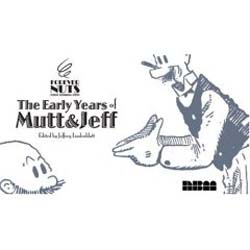Classic Screwball Strips: THE EARLY YEARS OF MUTT & JEFF

By Bud Fisher – edited by Jeffrey Lindenblatt (NBM)
ISBN 13: 978-1-56163-502-3
This is a welcome addition to a growing pool of classic strips that are finally being collected into accessible forms for posterity and enjoyment. Bud Fisher’s Mutt and Jeff is arguably the world’s first comic strip to employ day to day continuity rather than individual escapades on a per diem basis.
Harry Conway “Bud†Fisher began the strip A. Mutt in 1907 as a topper to the racing pages of the San Francisco Chronicle. His cartoon wastrel’s gimmick was to bet on the runners and riders of that day’s paper, with the results – good or bad – making the bones of the next day’s strip. When his career took off – first at the more cosmopolitan San Francisco Examiner and then into national syndication, such a limited, local mcguffin was impossible for a strip running across a continent.
Thus a vaudeville style comedy partner and more general topics became the norm. The premise of two ordinary, average – if dumb – Joes remained the strip’s basis until it eventually closed in 1983.
Although of undoubted historical value, the slapstick roots of these everyman characters meant that gags were the currency, and the sensibilities employed – and appealed to – were often harsh, sexist, and very often quite racist by today’s standards. Or were they?
Undoubtedly the physical depiction of Negro, Mexican British, French, Turkish and the other non-W.A.S.P. Americans never deviated from the graphically stereotypical. Certainly young women were always sexy and older women were grim battleaxes whilst rich people were always fat. But I suspect that that was as much comic shorthand as wilful malice aforethought.
Certainly for every gag that portrayed stupid, slow or cowardly black people there was another when the stereotype outwitted the protagonist. For every dim blonde or dumb Hausfrau there was a female sharpie who made the boys into the goats. Could it be Fisher was just a child of his time, knew his audience and was just going for the laugh wherever it was with no thought of political or social relevance?
Perhaps Fisher or his innumerable and often anonymous ‘ghosts’ (among whom Ed Mack and latterly Al Smith were the most prominent) weren’t as evolved as us.
Fisher was a notoriously “absentee†creator who regularly missed deadlines and had a string of substitutes to produce the strip for him once he became comics’ first millionaire. Occasionally he would even suspend the strip entirely. Yet the feature was never discarded by client newspapers. It was that popular.
This volume collecting strips from 1909-1913 is not without flaws. Often the heroes are pretty unlikable when they aren’t being winningly daft or actually funny. There are moments of genuine racism and sexism but also uncharacteristic challenges to that historical status quo of broad stereotypes. On a technical note there is bad editing as some strips are repeated. Was the designer asleep? Weren’t there enough good ones to fill the pages?
I know that last charge isn’t true. Despite the implications of the somewhat apologist introduction from historian Allen Holtz, Mutt and Jeff was a huge multimedia hit for nearly eighty years and they are still household names today. Moreover, read in context and on their own terms, they are still brilliantly hilarious slapstick gag strips. If you’re prepared to read with an open mind you might be pleasantly surprised.
No © invoked. Any helpful suggestions?
